
The Serious Freshening
Go to <Last, Summary, Next>Engine—New Head Bolts
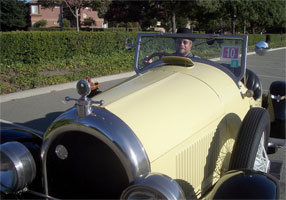 Lynn in Bugsby, September 5, 2005 |
Completed: 2007-11-17 — Started: 2006-01-26
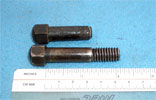 |
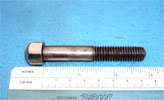 |
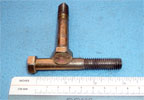 |
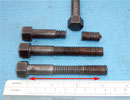 |
| HEAD BOLTS: As Lynn received Bugsby in 2005, the head had two different styles of bolts. In two of the locations, a 9/16"-head, black-oxide-finish bolt was used (left). In the remaining 20 locations, a 5/8"-head, nickle-finish bolt was used (left center). Unable to secure replacements, Lynn initially uses grade-8 bolts that he obtains from his local hardware store (center right). High head bolts that he obtained from RSC (right) are not very strong. Originally 3" long, they easily stretch and break before he can torque them to 50 ft-lb. |
Work Completed:
As originally delivered to Lynn, Bugsby has two different styles of bolts in the head.
From their appearance, Lynn suspects that the two 9/16" headed, 7/16"-14 (length unknown)
black-oxide-finish
bolts are older than the other twenty 5/8" headed, 7/16"-14 x 2-15/16" nickle-finish bolts.
Lynn thinks that a previous owner obtained twenty new head bolts (did they come as a set of 20?)
and reused two of the originals.
When Lynn attempts to remove the head, one of these old black-oxide bolts snaps off in the block
and it takes the services of the machine shop at
D & M Auto Parts to remove the corroded stump from the block.
In late January, 2006, Lynn contacts Restoration Supply Company and inquires about replacements. Lynn is told that RSC is temporarily out of the size he needs, but that they will be ordered. It will not be until July that RSC is able to deliver these bolts.
In the meantime, Lynn buys grade-8 7/16"-14 x 3" bolts from his local hardware store. These bolts are a little too long for a few holes as the bolt appears to bottom. Lynn grinds ~1/8" off these bolts.
Also, the top of bolt at the extreme forward position on the head is tight up against the thermostat housing. It isn't possible to get a thin walled socket over a 5/8" headed bolt in this position. (This is a second indication that the 9/16" headed bolts were original.) Initially, Lynn uses the sole remaining 9/16" headed bolt that he got with the car in this position. However, it too eventually snaps, but the stub is easy to remove. Lynn uses a grinder to cut a little more space in the thermostat housing around the bolt head. After these modifications the grade-8 bolts work great and the only unsatisfactory aspect is that the head (too slim, wrong color, strength marks) is not period correct for the vehicle.
(Anticipating his growing impatience, RSC supplies Lynn chrome acorn caps in June to hide the strength marks on his OSH grade-8 bolts. The chrome finish is also not period correct, but it looks way better to most people than the grade-8 head.)
In September, Lynn decides to install his new RSC high head bolts. At 50 ft-lb of torque, his first stop on the way to 65 ft-lb, several of the bolts stretch and one snaps. Yikes! Fortunately, the stub of the broken bolt is fairly easy to remove from the block after drilling and use of an E-Z-out bolt extractor.
U.S. Bolt Torque Specifications for 7/16"-14 Bolts
| S.A.E. Bolt Hardness |
Torque (ft-lb) | |
| Dry Threads | Oiled Threads | |
| 2 | 24 | 17 |
| 5 | 50 | 35 |
| 7 | 60 | 45 |
| 8 | 70 | 55 |
Lynn uses copper gasket sealer to coat all the threads (as the holes penetrate through to the water jacket) and this could easily qualify as a lubricant on the threads. Lynn is surprised to learn that the torque specifications for lubricated threads are much lower than for dry threads. The stretched/snapped bolts at 50 ft-lb imply to Lynn that the strength rating of these bolts is probably a S.A.E 5 or 6.
In November, 2006, Lynn orders a second set of high-head bolts from RSC. He torques them to about 35-40 ft-lb, his current recommended torque for lubricated Kissel head bolts.
Work Remaining:
None.
Contact
 with your comments or questions
with your comments or questionsCopyright © 2018 Lynn Kissel
Last updated: May 24, 2009